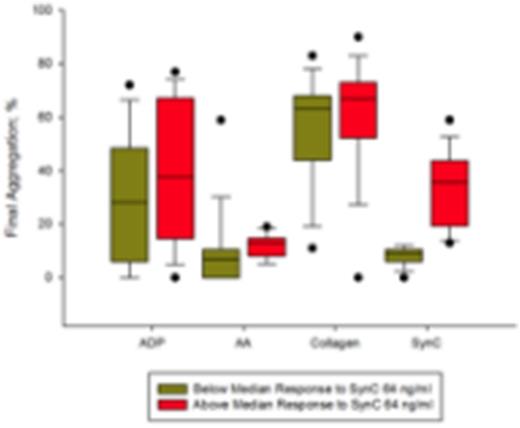Abstract
Introduction: Patients with coronary artery disease (CAD) are treated with aspirin and a P2Y12 antagonist to prevent myocardial infarction or stent thrombosis. Variable clinical response to both types of agents has been reported. Existing assays to identify sub-optimal response to anti-platelet therapy do not meet reported medical needs.
Aim: To characterize the utility of a synthetic collagen (SynC) to monitor platelet function in patients on dual-antiplatelet therapy.
Methods: Blood samples from healthy individuals (n=5) and CAD patients treated with clopidogrel (75-600 mg) with or without aspirin (75-325 mg) (n=51) were centrifuged to produce plasmas for aggregometry studies (PAP 8E, Bio/Data Corp. Horsham, PA). The aggregation response to 20 µM ADP, 500 µg/ml arachidonic acid and 190 µg/ml Type 1 biologic collagen was compared to that induced by SynC (2-200 ng/ml; JNC Corp., Yokohama, Japan). The aggregation response was characterized in terms of % aggregation, slope and AUC.
Results: The average age of the enrolled patients was 65.8 years (range: 48-83 years); 35 were male and 16 were female. CAD patients exhibited the common co-morbidities of hypertension (65%), hypercholesterolemia (55%), diabetes (37.3%) and obesity (10%) and as such received concomitant treatment with β-blockers (73%), ACE inhibitors (25%), calcium channel blockers (22%), statins (84%) and anti-diabetics (47%). Using plasmas from healthy individuals and CAD patients, two lots of SynC produced a concentration-dependent aggregation response over a concentration range of 16 to 128 ng/ml. Patients treated with 81 mg aspirin and 75 mg clopidogrel (33 of 51 patients) were stratified into two groups based on their % aggregation response to SynC, using the median % aggregation as the cut point. While the two groups had a distinct response to SynC, the median responses to ADP, arachidonic acid and biologic collagen were nearly the same and there was a strong overlap between the responses to these agonists in the two sub-groups. This is most evident at the lower concentrations of SynC.
Conclusions: SynC-induced platelet aggregation may identify sub-groups of patients with sub-optimal response to dual antiplatelet therapy that go undetected with traditional platelet agonists. Studies to clarify why biologic and synthetic collagens have different sensitivities to aspirin and clopidogrel are warranted.
No relevant conflicts of interest to declare.
Author notes
Asterisk with author names denotes non-ASH members.


This feature is available to Subscribers Only
Sign In or Create an Account Close Modal